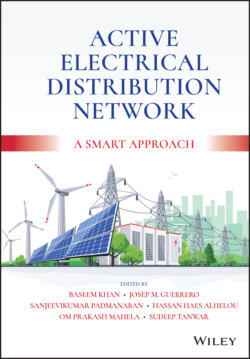Читать книгу Active Electrical Distribution Network - Группа авторов - Страница 42
2.1 Introduction
ОглавлениеTraditionally the electricity supply industry was monopolistic in nature with generation, transmission, and distribution owned by the Government. This system has also brought inefficiency and corruption due to policies and regulations. Many state-owned utilities are financially not solvent due to theft and lack of recovery of revenue. Further, in this model it was technically difficult to identify various issues in the distribution sector. Therefore, new mechanisms are required to make the system more efficient [1–5].
The Indian agriculture sector is one of the key sectors of the Indian economy and accounts for 18% of the country’s GDP and employs 50% of its labor force [6]. However, it is considered as an inefficient sector as far as the use of electricity is concerned. The major reasons for the continued inefficiency of the agricultural sectors are due to heavy subsidies or free electricity supplies and the absence of any provision of incentives for efficient use. The inefficient use of ground water for agricultural purposes and the use of inefficient motors instead of electric pumps further reduces the overall efficiency. More than 80% of the country’s water resources is consumed by the agricultural sector [6] and more than 60% of water used for irrigation is ground water [7]. Hence the necessity to segregate the agriculture feeder from the domestic feeder was acknowledged by Indian utilities.
To promote the implementation of feeder segregation in India, the Government of India has been trying since 1996 but it has only been effective since 2013 by projecting the process of feeder segregation as a national level scheme. The main objectives of this scheme are to guide, monitor, finance, and promote the process of feeder segregation in different agricultural-intensive Indian states. This scheme is included under Deen Dayal Upadhyay Gram Jyoti Yojana (DDUGJY) and a total cost of Rs. 4303.3 million was approved in December 2014 to separate the agricultural and non-agricultural feeders. The other achievable benefits through feeder segregation are the availability of 24×7 three-phase supplies to rural consumers, better regulation of supplies to agricultural customers that ensures improved load management, reduction in line losses, and an improvement in ground water husbandry. As the electricity is made available to the farmers either free of cost or at a highly subsidized rate, farmers misuse this facility by running the agricultural pumps for more than the required number of hours actually required to irrigate the crops. Hence there are wastages in electricity as well as ground water. Thus, to avoid the misuse of electricity by the farmers, power is being supplied to the agricultural feeders for a restricted number of hours by segregating the feeder catering to the agricultural loads from the domestic loads. However, the possibility of theft of line conductors, transformers, and other electrical elements fitted to the agriculture feeder increases during the off hours in these feeders. Such practical incidences of theft have been experienced by many Indian utilities who have implemented feeder segregation. Hence this is one of the biggest hurdles and challenges to the agriculture feeder segregation scheme.
Electric motors are mainly used to lift ground water. Data published by India Infraline in 2014 shows that more than 15 million grid-connected pump sets and around 8 million diesel-powered pump sets are being used for irrigation purposes. As the electricity is supplied at highly subsidized rates, farmers use inefficient, low-cost pump sets and pump ground water excessively – more than is required. Today, almost all agriculture-intensive states subsidize electricity to agricultural customers, either fully or partially [8]. The state government is required to meet the subsidy but any delayed or partial release of the subsidy by the state government places an unplanned and unbudgeted burden on the utilities. This constraint often encourages utilities to restrict power to non-remunerative agricultural pump sets to about 6–8 hours a day.
This restriction in supply hours has led farmers to use an automatic starter. The use of an automatic starter results in a heavy initial load while power goes and comes, causing a heavy burden on the infrastructure. Again, many farmers do not use capacitor banks, which causes voltage fluctuations and a poor power factor. The above factors lead to frequent motor burnouts and hence farmers have moved to using low-cost pump sets, which are less efficient but fluctuation-resistant. Other reasons that contribute to the vicious cycle of inefficiency are the reluctance of state utilities and political expediencies. Different studies show that the average efficiency of the agricultural pumps used in India ranges between 20 and 30% as opposed to that of the Bureau of Energy Efficiency (BEE) star-rated pumps of more than 55% efficiency.
Hence, to replace these inefficient pump sets with efficient ones, an agriculture demand side management (DSM) program has been initiated by the Indian Government, but this program did not succeed due to many technical and non-technical reasons. Hence the process of feeder segregation has been adopted as the best solution for improving efficiency through efficient use of electricity and better husbanding of ground water. However, the possibility of theft of line conductors, transformers, and other electrical elements fitted in to the agriculture feeder increases during the off hours in the feeders. Hence, to deal with the problem of theft, a network reconfiguration can be used as a theft handling method. Network reconfiguration done by changing the normal topological structure of the distribution feeder to a new objective-based structure through closing and opening of the sectionalizing and tie switches. If the agricultural feeder is included as part of the feeder reconfiguration, electricity will be made available during off-feed hours and hence the thieves will not take the risk.
